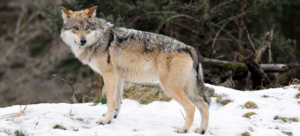For Immediate Release March 5, 2024
Contacts:
Greta Anderson, Western Watersheds Project (520) 623-1878; greta@westernwatersheds.org
Claire Musser, Grand Canyon Wolf Recovery Project (928) 202-1325 claire@gcwolfrecovery.org
Regan Downey, Wolf Conservation Center (914) 763-2373, regan@nywolf.org
Craig Miller, Defenders of Wildlife (520) 623-9653 cmiller@defenders.org
Mary Katherine Ray, Rio Grande Chapter Sierra Club (575) 537-1095 mkrscrim@gmail.com
Sally Paez, New Mexico Wild (505) 350-0664; sally@nmwild.org
MEXICAN GRAY WOLVES NUMBERS GO UP, BUT NUMBERS AREN’T THE WHOLE STORY AND POPULATION STILL DANGEROUSLY LOW, SAY GREENS
Mexican gray wolf population count increases, but lobos are still among
rarest species in the southwestern U.S.
ALBUQUERQUE, New Mexico – The U.S. Fish & Wildlife Service (Service) released the results of its 2023 wild Mexican gray wolf population count today, revealing that the number of wolves in the wild in Arizona and New Mexico increased to a minimum of 257 wolves. This development isn’t all positive, however, as the wild population’s genetic crisis becomes harder to fix as the population expands. While the Service continues to define recovery of the species according to the overall population count, conservation groups point to the lack of genetic diversity as a long-term threat to the species.
“It’s bittersweet to see the numbers of wolves in the wild increasing, knowing that very little is being done to address the high levels of inbreeding in that population,” said Greta Anderson, deputy director of Western Watersheds Project. “The agencies will claim this new benchmark shows a trajectory to success, but they aren’t measuring the indicators of genetic diversity which must be addressed with improved policies around adult and family group releases.”
“The survival of some cross fostered pups, including one born at the Wolf Conservation Center in 2023, is a testament to the love and support shown by wolf parents to their families, but cross foster survival alone won’t fix the genetic crisis. There are hundreds of lobos in captivity, each waiting for the opportunity to reclaim their ancestral homes. We should aim to solve two problems at once and resume adult and family group releases to improve wild genetic diversity and create space in captive facilities,” said Regan Downey, director of education at the Wolf Conservation Center.
Wolves also need access to additional suitable habitat where packs can spread out and provide ecological benefits as a keystone species. Unfortunately, political opposition to expanded habitat into northern Arizona and New Mexico has also hampered the recovery of the species by preventing multiple subpopulations that science shows the lobos need.
“The best available science shows us that suitable wolf habitat exists in the Grand Canyon ecoregion, north of the arbitrary I-40 boundary. Wolves need to disperse for their recovery to be successful, and our wandering wolves should be granted the freedom to roam and establish their packs wherever they choose,” said Claire Musser, executive director of the Grand Canyon Wolf Recovery Project.
The border wall between the United States and Mexico also continues to block wildlife movement and habitat connectivity. It has prevented Mexican gray wolves from freely moving back and forth between the US and Mexico populations, further jeopardizing recovery and exacerbating the genetic isolation of the two existing populations.
“The overall growth in the numbers of Mexican wolves in the wild is the result of hard work and coordination between many partners,” said Craig Miller, senior Southwest representative for Defenders of Wildlife. “But without more effort to improve the genetics of the population, we can’t celebrate yet. We have a long way to go for the Mexican gray wolf to fulfill its ecological potential.”
“As someone who for the first time recently heard a pair of wolves howling into the mountain night, I was awestruck by the haunting beauty of the sound,” said Mary Katherine Ray, Wildlife Chair for the Rio Grande Chapter of the Sierra Club. “I know these wolves are too closely related and much more needs to be done to address their lack of gene diversity. The alternative is a population that is at risk of extinction a second time no matter how many there are in the wild now. The mountain night losing its wild wolf howls again is unthinkable.”
“The expanded Mexican gray wolf population would not be possible without the protection of wild places like the Gila Wilderness, which celebrates its centennial anniversary this year,” said Sally Paez, staff attorney for New Mexico Wild. “Having more of these keystone predators on the landscape will improve ecosystem health and provide more opportunities for people to see and hear the species in the wild.”
Forward-thinking management is needed to ensure that Mexican gray wolves have the freedom to roam and the legal protection they need to thrive in the wild, including management policies that adequately address the impacts of illegal killing, the risk of genetic inbreeding, climate change, and habitat encroachment.
Background on Mexican Gray Wolves:
The lobo, or Mexican gray wolf, is the smallest, most genetically distinct, and one of the rarest subspecies of the gray wolf. These native southwestern wolves were listed under the Endangered Species Act in 1976 after being eradicated in the wild. Reintroduction efforts began in 1998, but conservation efforts have suffered without the implementation of recommended recovery actions.
For years, scientists have recommended to the Service that there be three subpopulations of at least 200 wolves each (with a minimum of 750 total), spread throughout the southwestern United States, including areas like the Grand Canyon Ecoregion and the Southern Rockies (Carroll et al. 2006; Wayne and Hedrick 2011; Carroll et al. 2014; Hendricks, et al. 2016). Scientists warn that this metapopulation structure and geographic distribution are imperative to the recovery of Mexican wolves. Unfortunately, we are still far short of this scientific recommendation.
Learn more at www.mexicanwolves.org.
###


